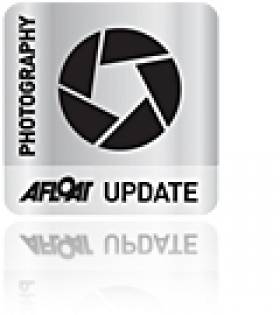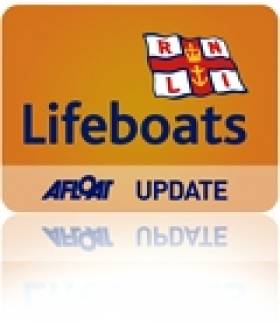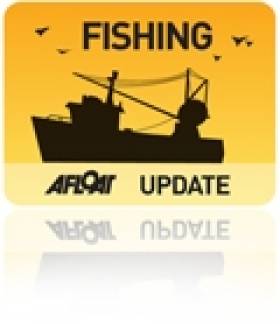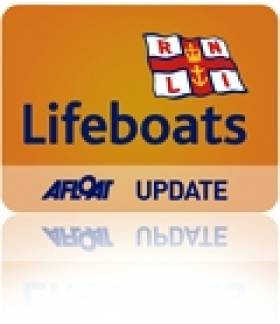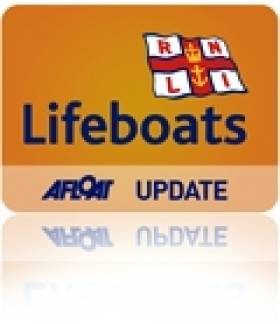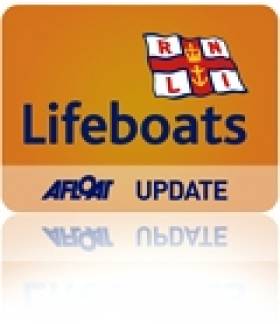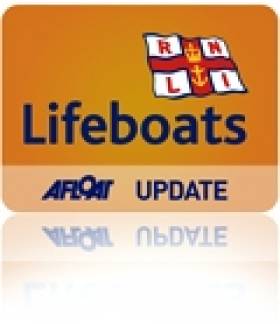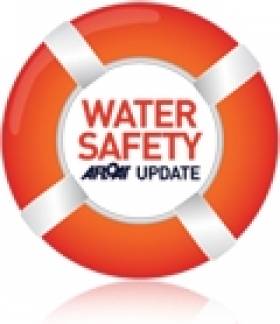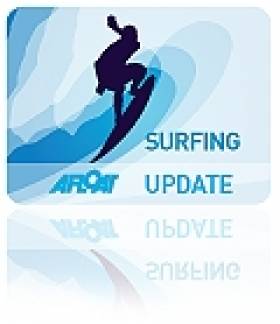Displaying items by tag: Wexford
#Earthquake - Just a few weeks after the Bristol Channel was stirred up by a 4.1 magnitude earthquake, TheJournal.ie reports of tremors felt in Ireland's south-east yesterday evening (18 March).
No damage has been reported on the relatively minor quake, the magnitude of which is awaiting confirmation from Irish seismologists.
But the tectonic trembling was felt in many parts of Wexford, and detected as far away as Wales across the Irish Sea.
That may put offshore sailors on alert over the coming weeks, following as it did not long after the Bristol Channel quake, not to mention a 2.6 magnitude rumble off the Cork coast late last year.
TheJournal.ie has more on the story HERE, including a link to a questionnaire for anyone who believes they felt last night's quake.
Cameras At The Ready For 'Wonderful Wild Wetlands' Photo Contest
#Photography - Over €500 in prizes are to be won in a new amateur photography competition to celebrate International Wetlands Day on 2 February 2014.
Held by Wexford County Council in partnership with the Irish Ramsar Wetlands Committee, the Wonderful Wild Wetlands Photography Competition is divided into two sections, with 18s and under and over 18s categories in both:
- ‘Wetlands in Wexford’ - a county competition where photographs may be taken in any location in Wexford
- ‘Wetlands and Farming’ - a nationwide competition where photographs may be taken anywhere in Ireland
The value of wetlands in the Irish landscape is that they embody and sustain a substantial percentage of our natural and cultural heritage, hosting a complex interaction of water, soil, plants and animals that fulfil many basic functions and provide important ecological services as well as being places of inspiration and consolation.
The winning images will be displayed in a special Wetlands photographic exhibition to be held in the County Hall of Wexford County Council during International Wetlands Day on 2nd February 2014.
To enter, be sure to make note of the following competition guidelines:
- All photographs must be original work, submitted as 10” (25cm) X 8” (20cm) hard copy unframed and on digitally on disc (original copies will be available for collection after exhibition)
- Please include competition category being entered, location and date photograph was taken
- Title, name, age (if 18 and under), address and contact telephone number on each entry
- Maximum of 2 entries per competitor
- 2 categories - Adult (over 18) Junior (18 and under)
- Photographs can be in black & white or colour
- Wexford Local Authority Employees are not eligible to enter
- The decision of the judging panel is final
- Please note you need a licence to take photographs of breeding birds, or any protected species, at or near their breeding site. These can be sought from www.npws.ie
The closing date for entries is Friday 17 January 2014. For submission details contact Niamh Lennon at Biodiversity & Forward Planning, Wexford County Council, County Hall, Carricklawn, Wexford or [email protected].
Search Resumes For Lobsterman Missing Off Wexford Coast
#RNLI - The search for a lobster fisherman missing off the Wexford coast was set to resume this morning after it was suspended at sunset last night.
RNLI lifeboats from Kilmore Quay, Rosslare and Fethard launched yesterday afternoon (Monday 25 November) to search for the fisherman after his boat was found empty at Shoal Rock, at the bottom of Great Saltee Island off Wexford.
The alarm was raised at 12.50pm after another fisherman in the area noticed that the boat had been stationary in the water for some time.
Kilmore Quay RNLI co-ordinated the sea search, and along with lifeboats from Rosslare and Fethard they were joined by up to 25 local boats in the search for the missing man.
The search was also joined by the Irish Coast Guard helicopter and divers from the Naval Service, who were taken to the scene onboard the Rosslare lifeboat.
Weather conditions yesterday were described as good and visibility was excellent.
Fishing Dispute Grounds Wexford Trawler Crews
#Fishing - The crews of 15 fishing vessels in Wexford operated by the O'Flaherty brothers have been temporarily laid off in a dispute over regulations, as RTÉ News reports.
It's emerged that the Sea-Fisheries Protection Authority last week issued orders for all 15 boats in the O'Flaherty fishing fleet to cease operations immediately, days after two boats were recently questioned over alleged infractions of fishing regulations.
The Department of Agriculture and the Marine has not commented on the reasons for issuing cessation orders to the O'Flahertys.
Seamus O'Flaherty - one of four brothers who operate the Kilmore Quay-based fleet - was in the news this time last year when he gave away free monkfish to the public on the quayside after exceeding the EU quota with his catch.
Jimmy Byrne, skipper of the O'Flaherty-owned Saltees Quest, defended the display as a protest against the EU mandate to discard all over-quota fish at sea - a practice that is hoped will come to an end with the new Common Fisheries Policy.
Wexford, Wicklow and Courtown Lifeboats Have A Busy Few Days
#RNLI - Wexford RNLI rescued two people late on Monday night (26 August) after their yacht went aground on a sandbank on the way into Wexford Harbour.
The volunteer lifeboat crew responded to the report of the yacht which had grounded near Ravens Point around midnight on Monday. Weather conditions at the time were good with a calm sea state and a north westerly force three wind.
But a fast-flowing tide of four knots meant that the inshore lifeboat and crew of the yacht had to work hard to refloat that boat.
Wexford RNLI lifeboat helm Peter Scallan commended the action of the yacht's crew, who he said were experienced sailors.
"The yacht's crew had taken all the correct precautions with the appropriate equipment on board to ensure their safety. They co-operated greatly with the lifeboat crew and as a result both they and their yacht were rescued."
Lifeboat crew member Alan Keville went onboard the vessel to assist in the manoeuvre to get the yacht off the sandbank, which involved using the mast to get the vessel on its side as the keel was stuck hard in the sandbank. The yacht was under tow at 1.14am and back in Wexford at 2.30am.
Elsewhere, the Courtown lifeboat launched on Sunday afternoon (25 August) to a report of a swimmer missing off Ardamine beach.
The lifeboat crew, who were in the harbour at the time, launched within minutes and commenced a search of the area. Irish Coast Guard helicopter Rescue 117 was also tasked to the scene, along with the Courtown coastguard unit.
After a thorough search of the area between Glasscarrig and Courtown pier, all rescue services were stood down as nothing was found. Courtown RNLI thanked all the members of public who helped and provided information during the call out.
The day before, the Wicklow RNLI inshore and all-weather lifeboats were launched after a member of the public reported seeing a small craft with two people drifting off Brittas Bay beach.
While the lifeboats were on route to Brittas Bay, they were requested to stand down and return to station by the coastguard as the boaters managed to make their own way ashore.
Speaking after the call-out, Wicklow RNLI lifeboat operations manager Des Davitt said: "While this turned out to be a false alarm with good intent, we are delighted that the public are being vigilant and contact the coastguard immediately when they suspect someone is in trouble on the water."
Busy Thursday For Wicklow & Wexford Lifeboats
#RNLI - It was a busy afternoon for RNLI lifeboats on the east coast on Thursday 8 August with separate call-outs in Wicklow and Wexford.
Wicklow RNLI's all weather lifeboat Annie Blaker was launched at 3.15pm to answer a call for assistance from a lone yachtsman experiencing mechanical difficulties off Wicklow Head.
As the crew assembled at the station, another call for assistance was received from a boat with four people in the same area.
The lifeboat launched immediately and located the small boat with four on board near Brides Head a short time later, but the occupants were in no immediate danger, so no further assistance was required as the boat was able to return safely to more sheltered waters under its own power.
The lifeboat then proceeded to the stricken yacht, located about two miles east of Wicklow Head shortly after 3.30pm. Weather conditions in the area at the time were described Force 4 with a south west wind.
The boat with the lone sailor was escorted back to Wicklow by the lifeboat. One of the lifeboat crew was transferred onto the yacht outside the harbour to assist with mooring the boat alongside the east pier.
Meanwhile in Co Wexford, the volunteer lifeboat crew at Rosslare Harbour RNLI launched their all weather lifeboat at 11am to assist an 11-metre fishing boat in difficulty.
The Arklow boat became entangled in fishing gear while north of Raven Point on the Wexford coast and lost all power. The fishing boat contacted the coastguard and the Rosslare Harbour RNLI lifeboat was launched and quickly on scene.
The weather conditions were described as good with a southerly Force 3 wind.
The lifeboat crew took the fishing vessel under tow as far as Cahore Point where the Arklow RNLI all-weather lifeboat took over the tow and brought them on to Arklow.
Speaking after the call-out, Rosslare RNLI volunteer deputy press officer Jamie Ryan said: “The emergency services reacted swiftly and help was on scene quickly. The three fishermen took the correct action in contacting the coastguard."
Kilmore Quay & Wicklow RNLI In Separate East Coast Assists
#RNLI - Kilmore Quay RNLI has assisted a fisherman after his boat got into difficulty off the Wexford coast, while Wicklow RNLI attended to a fishing boat in trouble south of Wicklow Harbour.
The Kilmore Quay all-weather lifeboat was requested to launch at 9.04am on Monday morning (29 July) to go to the assistance of a local lobster boat with one person on board,
The fishing boat had fouled its propeller while hauling pots a mile to the south-east of the Little Saltee Island.
Weather conditions at the time were blowing a light southerly breeze and there was good visibility.
When the lifeboat arrived on scene, a tow was set up and the vessel was brought safely to the harbour at Kilmore Quay.
Shortly afterwards, Wicklow RNLI launched at 9.30am in response to a call for assistance from a fishing vessel in difficulties six miles south of Wicklow Harbour.
The vessel with three crew was fishing north of Brittas Bay beach when a rope got fouled in the propeller and she lost steering. The skipper contacted the coastguard for assistance.
Wicklow town's lifeboat, under the command of coxswain Nick Keogh, located the vessel drifting close to the Wolf Rock 20 minutes after launching.
A towline was quickly established and the stricken vessel was towed back to Wicklow Harbour, where she was secured safely alongside the East Pier at 10.40am.
The crew on the call out were coxswain Nick Keogh, mechanic Brendan Copeland, Tommy McAulay, Kevin Rahill, Carol Flahive, Paul Sillery and Graham Fitzgerald.
#RNLI - The volunteer lifeboat crew of the Courtown lifeboat launched last Wednesday evening (24 July) to a report of a small fishing boat that was overdue on its time to return to Cahore Pier.
The Courtown RNLI lifeboat, Cahore Inshore Rescue, the Rosslare RNLI lifeboat and the Irish Coast Guard helicopter Rescue 117 were all tasked at 7pm to search the area of Cahore on the north Wexford coast, where the boat was last reported fishing.
After searching for some time, the small fishing boat made contact to say they had beached their boat some eight miles north of Cahore Pier at Kilgorman Beach. Both men were safe and well and all rescue services were stood down.
The Courtown lifeboat has since urged all boat users carry a proper means of communication - ideally a VHF radio - and to keep friends and family up to date on their location, especially if they decide to change their location.
That same evening, Rosslare Harbour RNLI was involved in a search for two fishermen after they reported getting into difficulty off the Wexford coast.
The volunteer crew launched their all-weather lifeboat at 7.30pm to assist in the search following a request from the coastguard to attend a fishing boat that was reported to be taking on water.
Weather conditions at the time were described as good, with a southerly force three wind.
The fishing boat had set out from Cahore Harbour before getting into trouble. The two crew raised the alarm using a mobile telephone.
Rosslare Harbour RNLI and lifeboats from Courtown RNLI and Cahore, along with the Rescue 117 helicopter, joined in the search.
At 7.50pm, Rescue 117 located the two fishermen safe and well and their vessel on the beach at Glasgorman, near Cahore.
Speaking after the call-out, Rosslare Harbour RNLI deputy volunteer lifeboat press officer Jamie Ryan said: "The emergency services responded swiftly and were on scene quickly.
"The two fishermen did the right thing by raising the alarm when they got into difficulty and thankfully they were both found safely ashore."
Rosslare RNLI Praises Emergency Caller Despite False Alarm
#WaterSafety - Rosslare RNLI has given credit to the quick-thinking member of the public who raised the alarm over what they believed to be a swimmer in difficulty - even though the call-out turned out to be a false alarm.
Lifeboats from Rosslare Harbour and Wexford RNLI were involved in the sea search on Friday evening (19 July) after a swimmer was reported to be in difficulty off Curracloe beach in Co Wexford.
The Irish Coast Guard helicopter Rescue 117 and two local fishing vessels were also involved in the search, which was stood down after an hour and 45 minutes upon coastguard request as no one was reported missing.
Speaking after the call-out, Rosslare RNLI deputy launching authority Dave Maloney said: "The member of the public who raised the alarm this evening deserves credit for doing so."
He added: "We would always encourage the public to alert the emergency services if they see anyone they believe to be in trouble or any signs of danger."
The message is particularly important in a fortnight that has seen a shocking 10 drownings around the island of Ireland - resulting in a big rise in emergency call-outs over the 2012 mid-summer period.
Elsewhere on the same day, the Ballycotton RNLI lifeboat was requested to help search the water off Ballinamona Strand in Ballycotton Bay, Co Cork, for a missing five-year-old girl.
The little girl was playing on the strand when her family lost sight of her. Emergency services were alerted and a search of the area commenced, but thankfully a short while later the little girl was located safe and well.
In other water safety news, the Irish Coast Guard has issued a public appeal for help locating a training mannequin that was lost in Galway Bay during an exercise off Blackhead in North Clare last week.
The Connacht Tribune reports that five coastguard mannequins were placed in the water to acts as people who jumped overboard from a ship fire - but only four were recovered afterwards.
Wexford Gets On The Surfing Map With First Surf School
#Surfing - Wexford now has its first ever dedicated surf school - thanks to two enterprising brothers.
The Wexford People reports on The Surf Shack in Curracloe, established by Chad and Jack-Tim Murray in an effort to put the Sunny South East on the Irish surfing map.
"Everybody knows that there are good waves on the West Coast," says Jack-Tim, referring to popular surf spots like Lahinch, Mullaghmore and Bundoran, "but most people don't even know that surfing exists on Ireland's east coast, let alone in Wexford."
The brothers aim to entice beginners to the sport, highlighting the smaller surf and safe swimming at Curracloe beach as the perfect environment for novices to ride the waves.
The Wexford People has more on the story HERE.






























